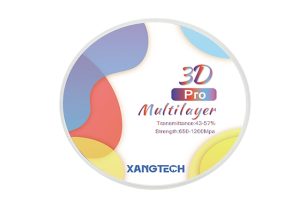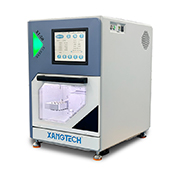What’s the Deal with Machining Accuracy in Dental Milling?
What’s Machining Accuracy in Dental Work?
Machining accuracy’s all about how close a dental milling machine gets to nailing the digital design of a restoration without screwing it up. In dental stuff, we’re talking microns (µm) and top-tier machines like the XANGTECH XT50 and RX-8Y hit tolerances as tight as 0.01mm. That kind of precision makes sure restorations fit like a glove in a patient’s mouth.
Why Precision’s a Big Deal for Dental Restorations
The fit and function of crowns, bridges, veneers and implant abutments hinge on how spot-on they’re milled. Mess it up and you get wonky bites, discomfort, or even a busted prosthesis. High machining accuracy means restorations match intraoral scans perfectly. That cuts down on chairside tweaks and boosts long-term toughness.
What Stuff Affects Machining Accuracy?
Toolpath Strategy and Calibration
Toolpath strategy’s how the milling tool dances across the material. Slick paths keep vibrations low and cuts clean. Regular calibration’s a must to keep digital designs and real-world milling in sync. Machines with auto-calibration features cut out human slip-ups big time.
Spindle Speed and Stability
Spindle speed’s about how fast the cutting tool spins. Cranking up to 60,000 rpm is awesome for fine details but needs serious stability to dodge chatter or tool wobble. XANGTECH’s machines hit those speeds, giving you smooth finishes even on tricky shapes.
Material Properties and Tool Wear
Stuff like zirconia’s way harder than PMMA or wax blocks, so it chews through tools faster if you’re not careful. Using the right burs for each material keeps accuracy on point by avoiding drift from worn-out tools.

How Do Fancy Dental Milling Machines Nail High Precision?
What Tech Makes Accuracy Pop Off?
5-Axis vs. 4-Axis Systems: Does Axis Count Matter?
Heck yeah—more axes mean better moves. A 5-axis system tilts and spins materials like a pro, milling undercuts and wild shapes without needing to reposition. 5-axis linkage cutting enables large-angle precision grinding, especially useful for implant-supported prosthetics.
Closed-Loop Control Systems and Real-Time Feedback
Closed-loop systems keep an eye on spindle load, axis positions and tool wear in real time, tweaking things on the fly to keep precision tight. They cut down on manual fiddling and keep batches consistent.
Why’s Software Integration Key for Spot-On Milling?
CAM Software Optimization for Dental Gigs
Computer-aided manufacturing (CAM) software turns digital impressions into killer toolpaths. Optimized dental CAM makes sure margin lines stay crisp and occlusal surfaces are bang-on.
Digital Workflow from Intraoral Scanning to Final Restoration
A smooth digital flow—from intraoral scans to CAD design to CAM output—keeps errors from piling up and wrecking fit. With the right dental milling machine, you can streamline workflows, crank up precision and make patients stoked.
Meet XANGTECH: The Big Dog in Precision Dental Milling
Who’s XANGTECH and Why Are Their Dental Milling Machines Fire?
We at XANGTECH have over 11 years of experience specializing in dental laboratory equipment such as zirconia blocks, PMMA discs, lithium disilicate materials and high-performance machines de fraise dentaire. Our mission is to deliver one-stop solutions and exceptional service to dental professionals worldwide.
How Do XANGTECH’s Machines Keep Accuracy Locked In?
High-Precision Spindle Systems and Solid Design
Our XT50 model rocks a high-speed spindle (up to 60,000 rpm) with a B-axis rotation angle from +350° to -910°, letting you mill big-angle implants with crazy detail. The le XT50 ensures accurate and consistent milling outcomes, even when handling anterior aesthetics or complex implant cases.
Auto-Calibration and Maintenance Alerts
To ditch human error, our RX-8H metal milling machine has smart features like auto-calibration, probe compensation, real-time process tracking and one-click cutting via Millbox software integration. Intelligent functions such as one-click calibrationensure that each cut is accurate and consistent.
What Kinds of Restorations Can XANGTECH’s Gear Handle?
Crowns, Bridges, Inlays, Onlays, Veneers
Our machines crush all standard restorative cases with ease using materials like zirconia blocks or lithium disilicate—both known for aesthetic excellence.
Implant Abutments and Full-Arch Prosthetics
Thanks to multi-axis control systems in models like RX-8Y or RX-8H, we support full-arch restorations requiring high strength materials such as PEEK or multilayer zirconia blocks with enhanced translucency.
What Should You Think About When Picking a Dental Milling Machine?
What Features Are Must-Haves for Long-Term Accuracy?
Axis Setup, Build Quality, Tool Management
You want multi-axis power (5-axis is the move), a beefy design to kill vibrations, automatic tool changers (ATC) and real-time monitoring to keep performance legit over time.
Compare different brands/models available considering performance factors such as precision speed capacity build quality ease-of-use integration support training space installation requirements etc.
How Big a Deal Is Material Compatibility for Precision?
PMMA, Zirconia, Wax, Lithium Disilicate
Each material’s got its own quirks, needing specific spindle speeds or coolant tricks (wet vs dry). Wet milling machines use a liquid coolantmaking them ideal for producing esthetic restorations like crowns. On the other hand,dry milling machines operate without liquid coolantsmaking them fasterfor materials like zirconia. Our gear handles both workflows with dedicated setups for each material.
Should You Go In-House or Outsource?
In-house systems give you mad control over turnaround time and quality while cutting outsourcing costs long-term. With more equipment options made more affordable by a competitive marketdoing your own milling in-house may not be that far from reality.

FAQ (questions fréquentes)
Q: What’s the usual tolerance for a top-tier dental milling machine?
A: Most high-end rigs hit around ±0.01mm, like our XANGTECH XT50 or RX-8H.
Q: How does tool wear mess with accuracy over time?
A: Worn tools screw up dimensions ‘cause their cutting shape changes; regular swap-outs are key to keeping precision tight across jobs.
Q: Can a desktop dental milling machine match a lab-grade one for accuracy?
A: Some desktop units start off decent, but maintenance is everything. Lab-grade machines often have closed-loop feedback systems that auto-fix wear or misalignment—stuff you usually don’t get in smaller rigs.












